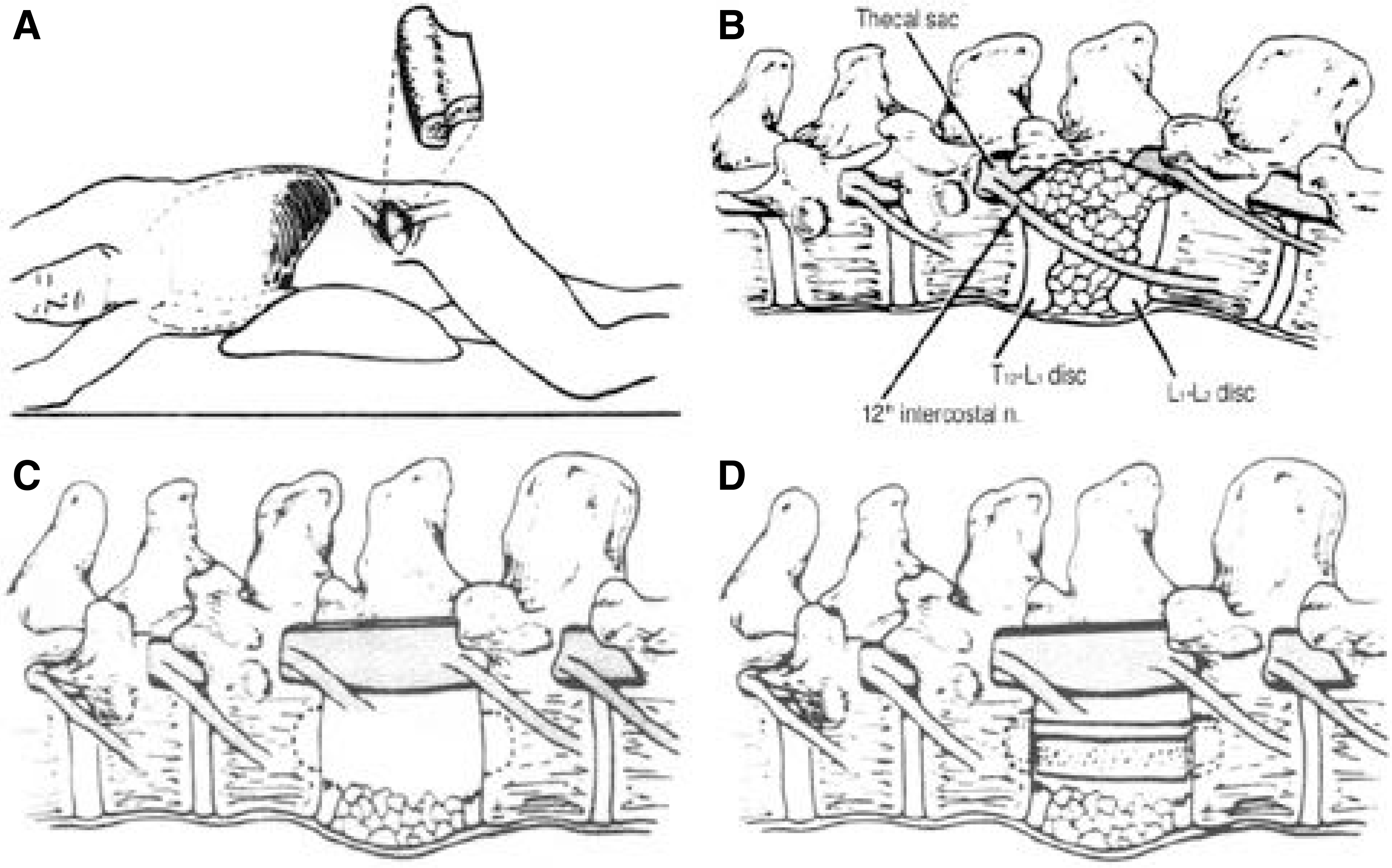Abstract
The anterior approach to the spine offers several unique solution to problems posed by patients with thoracolumbar injuries. The major weight- bearing elements of the spine are anterior and this is the area where injured elements impinging on the spinal cord can cause significant but reversible damage. The two primary areas of concern for surgeons treating these patients are restoration of mechanical stability of the spinal column and restoration or preservation of neurologic function. Indications for anterior decompression, 1)a large retropulsed fragment with significant(>50%) canal compromise, 2)anterior column comminution and marked kyphosis, and a time lapse of greater than 10 days from the time of injury. A nterior approaches are also recommended for the late treatment of symptomatic posttraumatic kyphosis that causes pain or neurologic deficit. The flexion- compression injuries addressed with anterior decompression and strut graft fusion require additional stability for satisfactory healing with maintenance of position assured during bone graft incorporation. A nterior instrumentation is most effective when balanced by an intact posterior ligamentous tension band. The anterior approach is more superior in canal clearance and effective in restoring bladder and bowel function.
Go to : 
REFERENCES
1). Bedbrook GM. Spinal injuries with tetraplegia and paraplegia. J Bone Joint Surg. 61B:267–284. 1979.

2). Bohlman HH, Kirkpatrick JS, Delamarter RB, Lev-enthal ML. Anterior decompression for late pain and paralysis after fractures of the thoracolumbar spine. Clin Orthop. 300:24–29. 1994.

3). Bradford DS, McBride GG. Surgical management of thoracolumbar spine fractures with incomplete neurologic deficits. Clin Orthop. 218:201–216. 1987.

5). Esses SI, Botsford DJ, Kostuik JP. Evaluation of surgical treatment for burst fractures. Spine. 15:667–673. 1990.

6). Freebody D, Bendall R, Taylor RD. Anterior trans-peritoneal lumbar fusion. J Bone Joint Surg. 53B:617–627. 1971.

7). Gertzbein SD. Neurologic deterioration in patients with thoracic and lumbar fractures after admission to the hospital. Spine. 19:1723–1725. 1994.

8). Gertzbein SD, Court-Brown CM, Jacobs RR, Marks P, Martin C, Stoll J, Fazl M, Schwartz M, Rowed D. Decompression and circumferential stabilization of unstable spinal fractures. Spine. 13:892–895. 1988.

9). Kaneda K, Abumi K, Fujiya M. Burst fractures with neurologic deficits of the thoracolumbar-lumbar spine. S pine. 9:788–795. 1984.
10). Kostuik JP. Anterior fixation for burst fractures of the thoracic and lumbar spine with or without neurological involvement. Spine. 13:286–293. 1988.

11). Malcolm BW, Bradford DS, Winter RB and Chou SN. Post-traumatic kyphosis. J Bone Joint Surg. 63:891–899. 1981.
12). Mann KA, McGowan DP, Fredrickson BE, Falahee M, Yuha HA. A biomechanical investigation of short segment spinal fixation for burst fractures with varying degree of posterior disruption. Spine. 15:470–478. 1990.
13). McAfee PC, Bohlman HH, Yuan HA. Anterio r decompression of traumatic thoracolumbar fractures with incomplete neurological deficit using a retroperitoneal approach. J Bone Joint Surg. 67:89–104. 1985.
14). Park HJ, Rah JH, Lee HK. Surgical treatment for the burst fracture of the thoracolumbar spine. J Korea Orthop Assoc. 29:457–486. 1994.
15). Park HJ, Rah JH, Yoo KJ. Operative treatment of thoracolumbar spine fractures with AO internal fixator. J Korean Orthop Assoc. 31:1116–1123. 1996.

16). Roberson JR, Whitesides TE. Surgical reconstruction of late post-traumatic thoracolumbar kyphosis. Spine. 10:307–312. 1985.

17). Yuan HA, Mann KA, Found EM, et al. Early clinical experience with the Syracuse I-plate, an anterior spinal fixation device. Spine. 13:278–285. 1988.

18). Zdeblick TA, Warden KE, Zou D McAfee PC, Abitol MD. Anterior spinal fixatiors. Spine. 18:513–517. 1993.
Go to : 
 | Fig. 1-A.The retroperitoneal approach to the first lumbar vertebra from the left through an incision overlying the twelfth rib. Fig. 1-B. Orientation to the spinal canal is facilitated by tracing the course of the twelfth intercostal nerve. After removal of the left pedicle of the first lumbar vertebra, the retropulsed vertebral-body fragments of a burst fracture of the first lumbar vertebra are seen compressing the thecal sac. Fig. 1-C. The vertebral body fragments are removed with a high-speed burr until the base of the opposite pedicle is visualized. Fig. 1-D. An iliac-crest tricortical strut graft is locked in place using bone tamps. Each end is countersunk into the vertebral body above and below. |




 PDF
PDF ePub
ePub Citation
Citation Print
Print


 XML Download
XML Download